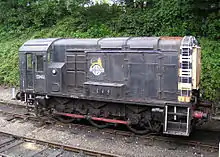British Rail Class 10
The British Rail Class 10 diesel locomotive was a variation on the Class 08 diesel-electric shunter in which a Blackstone diesel engine was fitted instead of one made by the English Electric company. Traction motors were by the General Electric Company plc (GEC); the class D3/5 were similar, but had British Thomson-Houston (BTH) traction motors.
| British Rail Class 10 | |||||||||||||||||||||||||||||||||||||
|---|---|---|---|---|---|---|---|---|---|---|---|---|---|---|---|---|---|---|---|---|---|---|---|---|---|---|---|---|---|---|---|---|---|---|---|---|---|
.jpg.webp) .D3634 (never renumbered in "10" series) in BR green at Stratford MPD, July 1967. | |||||||||||||||||||||||||||||||||||||
| |||||||||||||||||||||||||||||||||||||
| |||||||||||||||||||||||||||||||||||||
| |||||||||||||||||||||||||||||||||||||
| |||||||||||||||||||||||||||||||||||||
The locomotives were built at the BR Works in Darlington and Doncaster over the period 1955–1962. At first they were classified D3/4, then 3/1C before becoming Class 10 under TOPS
Technical details
- Engine: Blackstone 6-cylinder, 4-stroke, ER6T
- Traction motors: 2 x GEC nose suspended motors
Withdrawn
The class were withdrawn between February 1967 and June 1972.
| Year | Quantity in service at start of year | Quantity withdrawn | Locomotive numbers |
|---|---|---|---|
| 1967 | 146 | 6 | D3151, D3449/96, D3620/28/31. |
| 1968 | 140 | 77 | D3139–40/42/46–48/51, D3439–48/50–53/73–78/80–82/84–85/87–91/93–95[lower-alpha 1]/97–99. D3500–02, D3624–27/30/32–33/35–37/40/43, D4064/71/76/80–94. |
| 1969 | 63 | 21 | D3143–44, D3479/83/92, D3612–14/16–19/21/23/29/38–39/42/45/47[lower-alpha 2]/49. |
| 1970 | 41 | 9 | D3137/49, D3486, D3638[lower-alpha 3]/44/47, D4052/67/77. |
| 1971 | 34 | 14 | D3141, D3634/41/46/48/50–51, D4050–51/53/55/59–60/65. |
| 1972 | 20 | 20 | D3138/45, D4049/54/56–58/61–63/66/68–70/72–75/78–79. |
- D3494 withdrawn due to accident damage
- Withdrawn July, reinstated August
- Reinstated March, withdrawn November
Preservation

D3452, at Bodmin on 28 August 2003. This locomotive is preserved on the Bodmin & Wenford Railway
Twenty locomotives were sold to industrial customers; of which, four have been preserved:
- D3452 at Bodmin and Wenford Railway
- D3489 at Spa Valley Railway
- D4067 at Great Central Railway
- D4092 at Barrow Hill Engine Shed
- A fifth example was stored on the Colne Valley Railway, though has since been scrapped.
References
- Strickland, David C. (September 1983). Locomotive Directory: Every Single One There Has Ever Been. Camberley, Surrey: Diesel and Electric Group. pp. 53–61. ISBN 978-0-9063-7510-5. OCLC 16601890.
- Strickland 1983, pp. 56–57.
This article is issued from Wikipedia. The text is licensed under Creative Commons - Attribution - Sharealike. Additional terms may apply for the media files.